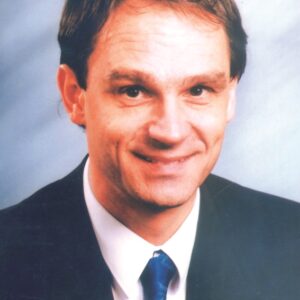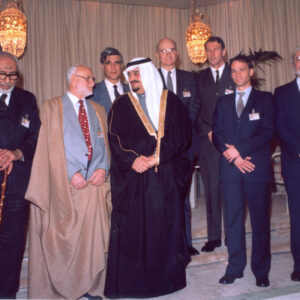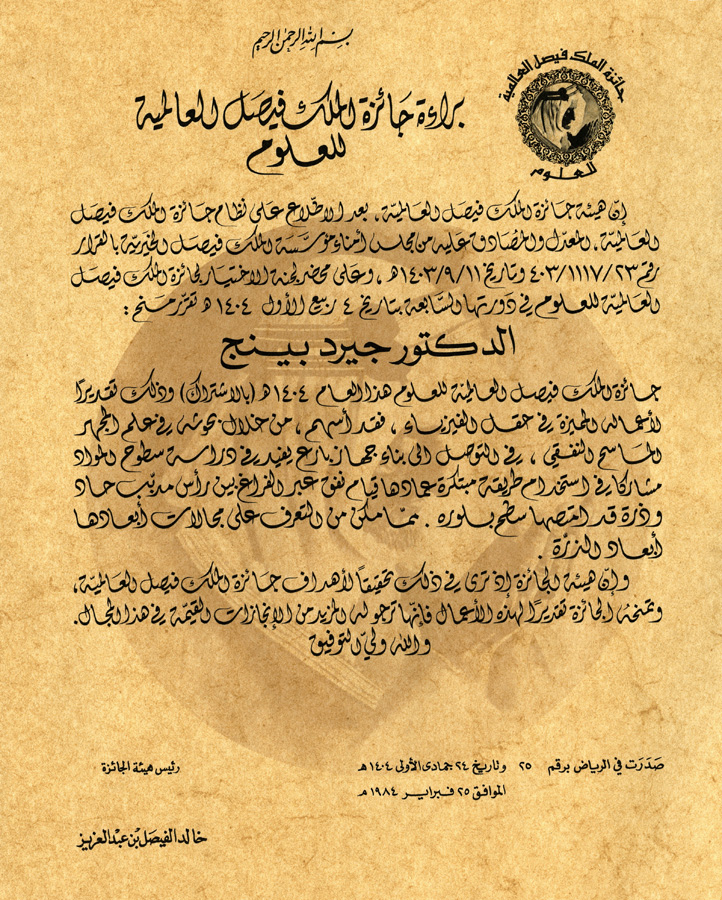

Professor Gerd Binnig
King Faisal Prize in Science 1984 Laureate
Topic: "Physics "

Professor Gerd Binnig was born in 1947 in Frankfurt. He was educated at J. W. Goethe University in Frankfurt, where he received his bachelor’s and Ph.D. degrees in 1973 and 1978, respectively. He joined a physics group at the IBM Physics Research Laboratory in Zürich. Between 1985-1986, Binnig was assigned to IBM Almaden Center, in San Jose, Calfornia. In 1987, he was appointed an IBM fellow and from 1987-1988, he was a visiting professor at Stanford University.
Professor Binnig met fellow researcher Heinrich Rohrer at IBM in Zurich. In 1981 the y built the first scanning tunneling microscope (STM), one of the most elegant inventions of the 20th century which allowed imaging of individual atoms. The STM soon proved to be an invaluable tool in many fields, including industry, metallurgy, semi-conductor research, electrochemistry and molecular biology. With the STM, Binnig was the first person to visualize a virus escaping a cell. For this innovation, Bennig and Rohrer were awarded the King Faisal International Prize for Science in 1984, and two years later they shared the Nobel Prize in Physics with Ernst Rusta who invented the first electron microscope.
In 1985, Binnig and others from IBM and Stanford University invented the atomic force microscope. This allowed imaging non conductive matter such as living cells to molecular resolution. Since then, every year has seen new inventions in the rapidly growing field of scanning probe microscopes. They are now imaging bits on magnetic surfaces, measuring temperature at microscopic sites, and monitoring the progress of chemical reactions.
In 1994, Binnig founded Definiens which turned six years later into a commercial enterprise that provides companies and institutions around the world with sophisticated technologies for analyzing and interpreting images on every scale. In 1989, Binning published his book Aus dem Nichts (Out of Nothing) which speculated that creativity grows from disorder.
In addition to the King Faisal and Nobel Prizes, Binnig (and Rhorer) received numerous prizes including the German Physics Prize, the Otto Klung Prize, the Hewlett Packard Prize, and the Restin Prize. Binnig was appointed honorary professor at the University of Munich since 1987 and was inducted to the US National Hall of Fame.
The two research works which he-published with Dr. Heinrich Rohrer at to the award of the King Faisal International Prize of the year 1404H., 1983 A.D. are:
- Scanning Tunneling Microscopy Surface Scierce 126, (1983) P 236-244.
- 7 x 7 Reconstruction on Si (III) Resolved in Real Space. Phy. Rev. Lett. 50, (1983) P 120-123.



